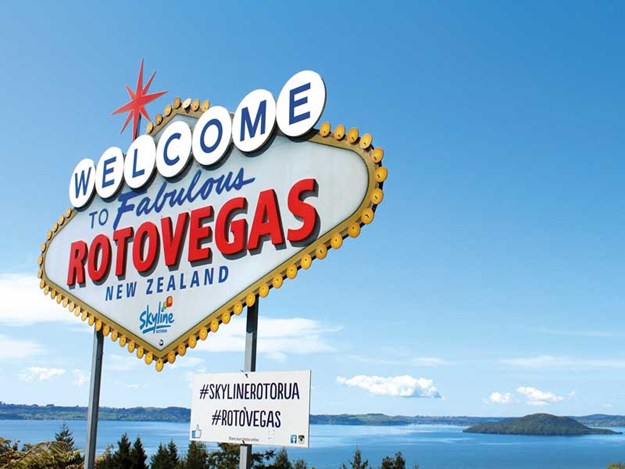
What happens in Vegas, stays in Vegas. Unless it’s Rotovegas, because chances are you’ll want to share details with friends, family, and Facebook pretty much straight away.
The buried village
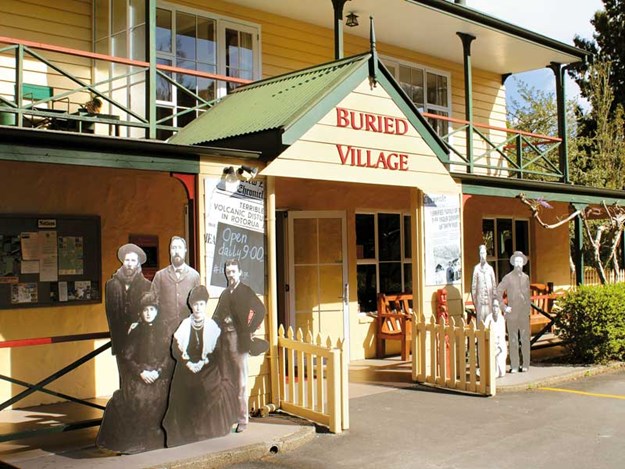 |
The Buried Village |
On 31 May 1886, Sophia Hinerangi, a revered guide to the world-famous Pink and White Terraces, was taking a group of tourists across Lake Tarawera when a ghostly apparition appeared. It was a phantom canoe, believed by Maori at the time to be ferrying the souls of the departed to the mountain of the dead.
Eleven days later on 10 June, the violent eruption of Mt Tarawera sent fountains of fire into the sky, raining down on nearby villages and settlements. Three villages were completely destroyed. Many believed the canoe sighting was an omen of the impending eruption – one of New Zealand’s greatest natural disasters.
After many years of slow, careful archaeological excavation, one of those villages, Te Wairoa, was opened to the public to explore. Excavation of the 12-acre site began in 1931 and continues on today.
Sites have been excavated back to floor level, with reconstructed whares (houses) being carefully built from the native materials originally used, such as ponga, fern, and rushes.
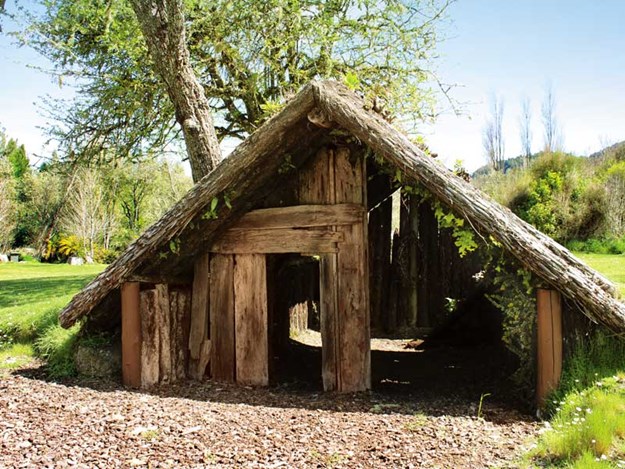 |
A reconstructed whare at the Buried Village |
A wander through the site takes around 40 minutes, offering visitors a unique opportunity to learn more about the fascinating history of the village. There’s also a museum on-site. which holds many of the excavated items and tells the stories of the people who lived there.
It’s a sombre experience, and the individual stories of those who perished in the village’s destruction are incredibly sad. But it’s also inspiring to learn about the vision and dedication of the Smith family, who now own the site and have worked so hard over the past 80-odd years to develop the site into what is now an award-winning heritage attraction visited by thousands of people from around the world.
Waimangu Volcanic Valley
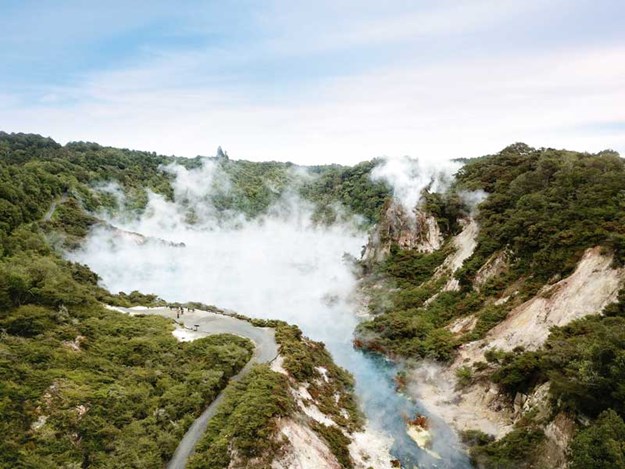 |
Waimangu Volcanic Valley |
About 35 minutes’ drive from the Buried Village is Waimangu Volcanic Valley, where visitors can immerse themselves further in the fascinating history surrounded the Tarawera region. Before the 1886 eruption, the Pink and White Terraces on the shores of Lake Rotomahana attracted intrepid tourists from around the world.
Formed by geo-thermally heated water rich in siliceous sinter, the beautiful terraces and pools were considered to be the eighth wonder of the world. Sadly, the terraces were destroyed when Mt Tarawera erupted, covering them in thick sediment and submerging them 50 metres beneath the lake, which increased by 20 times its size after the eruption.
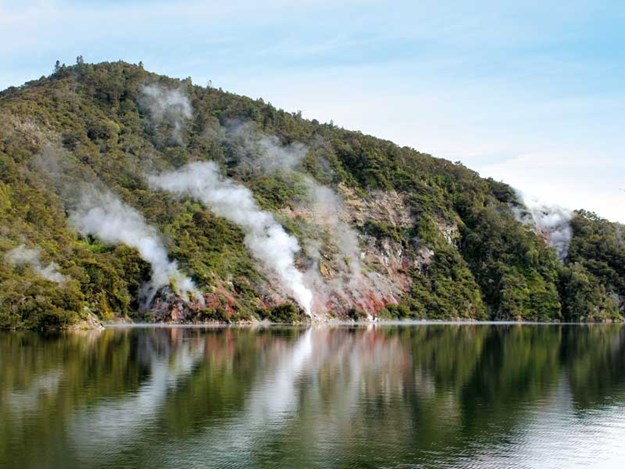 |
Steam vents along Lake Rotomahana |
Today, visitors to Waimangu Volcanic Valley can take a self-guided walk through the valley, with a variety of walking tracks ranging between 1.5km and 4km.
As you start out on the path, it’s a little like taking a step back in time. The vast valley of green bushland stretches on for miles, an ever-present shroud of thermal mist hangs lazily in the air. The only sound—an occasional call of a kereru or the peeps of busy fantails seeking out bugs for breakfast.
The walk takes visitors past craters—including the brilliantly blue Inferno Crater—geysers, a hot water creek, hot springs, and crystal formations. At the end of the walk, visitors can board the Ariki Moana vessel for a 45-minute cruise across Lake Rotomahana to learn more about the history and eruption of Mt Tarawera, including visiting the sites of the Pink and White Terraces.
Te Puia
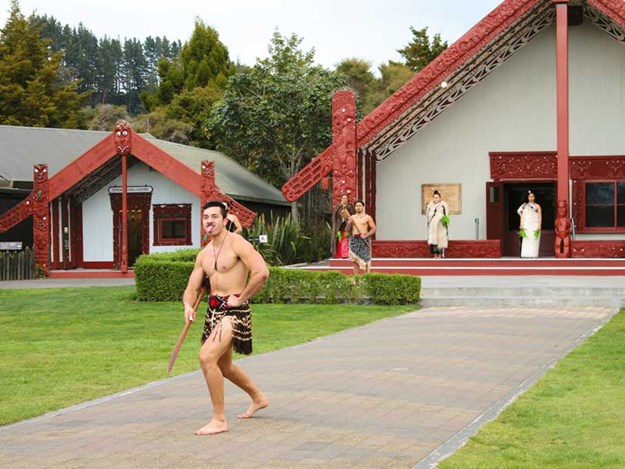 |
A traditional welcome at Te Puia |
For international visitors to Rotorua, Te Puia is often a must-see part of their itinerary. But it’s one of those destinations that Kiwis often overlook on their travels, which is a shame because it offers a truly memorable cultural experience. Spanning 60 hectares, you’ll want to set aside at least half a day to visit Te Puia, if not an entire day (and into the night).
Home to the New Zealand Maori Arts and Crafts Institute, students of carving, weaving, and other traditional arts come to Te Puia to train under the guidance of master craftspeople. And it’s fascinating to watch these dedicated and proud students create beautiful traditional flax garments, and intricate bone and stone carvings.
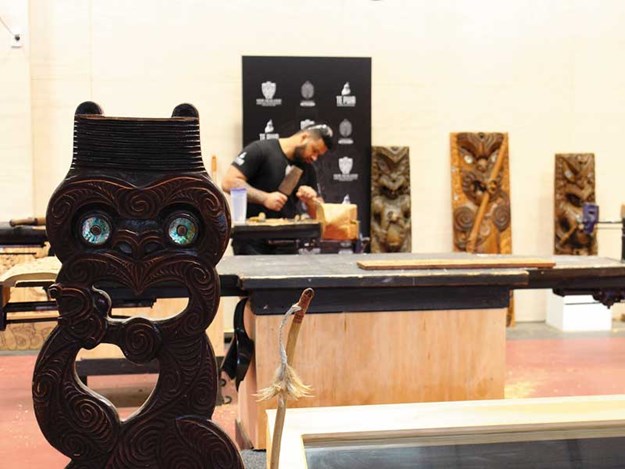 |
A carver at work |
Te Puia is also home to the world-famous Pohutu Geyser, the largest active geyser in the southern hemisphere. The geyser erupts once or twice every hour, shooting water and stream sometimes as high as 30 metres.
Visitors can also get up close with our national icon, the kiwi, at Te Puia’s kiwi house. Te Puia is part of a national programme to protect and breed kiwi, as well as native skinks.
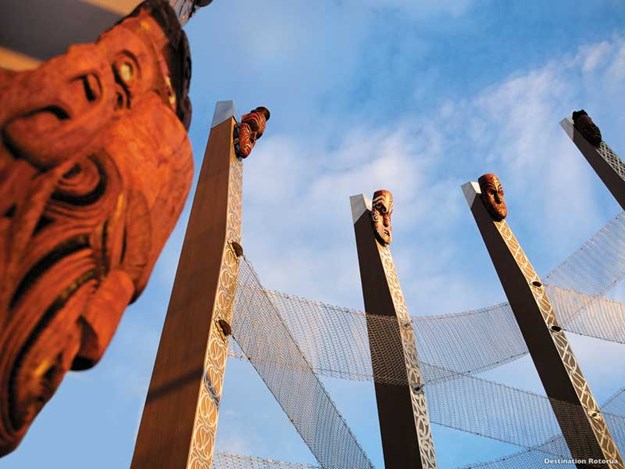 |
The stunning carvings outside Te Puia |
Te Puia offers day tours (Te Ra) and night tours (Te Po) which gives visitors an immersive experience of everything on offer at Te Puia. The night tour also includes a delicious Maori banquet, prepared in the traditional hangi style.
Redwoods treewalk
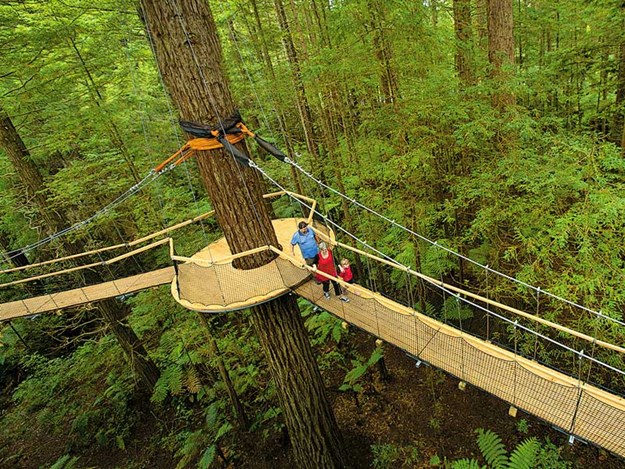 |
Rotorua’s Treewalk includes 28 suspension bridges |
Nestled in Rotorua’s Whakarewarewa Forest—one of the oldest exotic forests in New Zealand—is the 117-year-old Redwood Forest, home to The Redwoods Treewalk. The forest has long been a drawcard for hikers, mountain bikers, dog walkers, horse riders, and those who just enjoy connecting with nature.
The Treewalk offers another way to do exactly that, and it’s a pretty cool way to do it, too. High (but not too high) above the ground, a series of 28 suspension bridges that create a pathway between 27 of the forest’s majestic Redwoods.
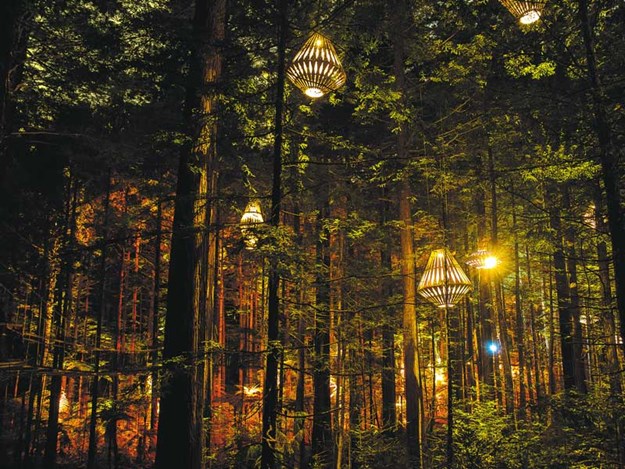 |
The Treewalk lit up at night |
During the day, the atmosphere is tranquil, forcing you to simply slow down, relax, and just appreciate the beauty of these magnificent trees. At night, the Treewalk takes on a more magical mood as massive bespoke designer lanterns that hang high in the trees are illuminated.
Each light was created by world-acclaimed design and sustainability champion, David Trubridge, and has been created to look almost as though they are part of the forest itself.
The Treewalk is suitable for any age and ability and has been designed to let you wander along at your own pace. And given just how relaxing and peaceful the walk is, you may well want to take your time, take a seat along the way, and just enjoy the view.
Rotorua skyline
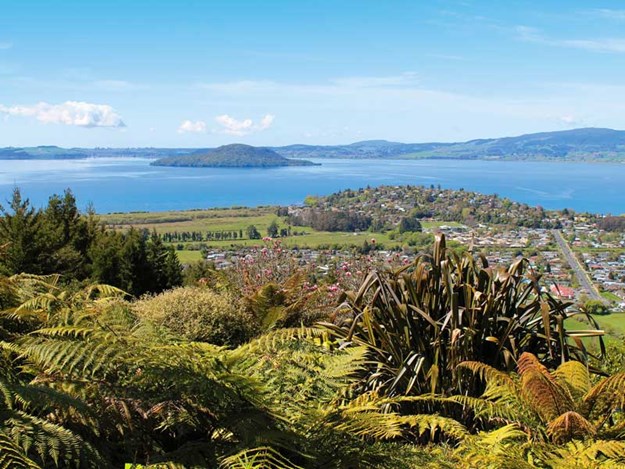 |
The incredible view from the Skyline |
If, like me, it’s been a while since you’ve been up the Skyline in Rotorua, I’m pleased to report that it’s very much worth another visit. My last visit was about 15 years ago, and from memory, there was a café and the luge, but not a lot else. Today, a trip up the Skyline is a full day experience, and if you’re not big on luging, there are plenty of other activities to choose from.
One of the popular activities, as evidenced by the continual stream of bikes heading up on the bike gondolas, is the 10.5 mountain biking trail network. And if you don’t have your own bike, you can hire one while you’re there.
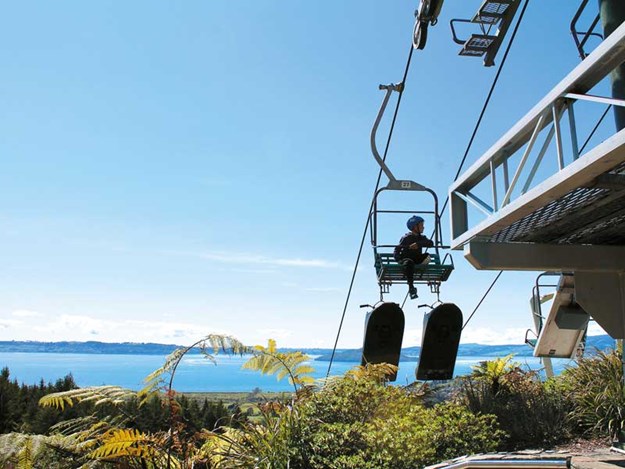 |
Luging in Rotorua offers some great views! |
What’s really great about the Skyline is that there are activities to cater for every age. Littlies will be kept busy riding the mini diggers, petting the friendly alpacas, and finding their favourite jellybean flavour at the Jelly Belly store.
For the very adventurous, the Zoom Ziplines and Skyswing promise an adrenalin rush, while for those who prefer to take it easy and enjoy the views, the Volcanic Hills winery and tasting room is a great spot to relax and enjoy good wine. And if you’re there over spring, the Nature Trail is fabulous—blossoms like you wouldn’t believe! All that activity does work up an appetite though.
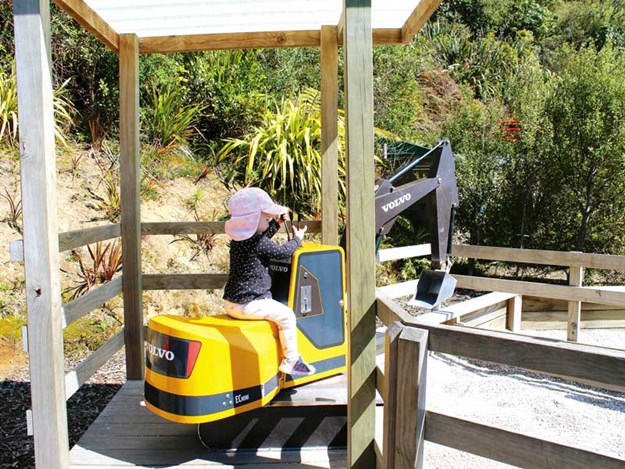 |
The Mini Diggers at Rotorua’s Skyline |
We enjoyed a buffet lunch at the Stratosfare Restaurant—home to some of New Zealand’s best award-winning cuisine (bookings recommended). The Market Café does a great range of meals also, from quick and tasty curries to fish ‘n’ chips and pizza. And, most importantly, their coffee is very good.
Waikite valley thermal pools and campground
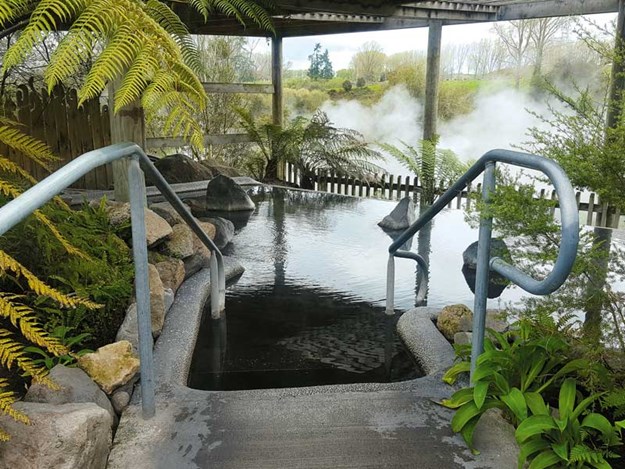 |
The Tranquil Garden Pool at Waikite Hot Pools |
I have to admit that until my most recent visit to Rotorua, I’d never heard of Waikite Valley, possibly because it’s a little out of the way. We came across the hot pools while having a bit of a tiki-tour along SH5 south of the township.
The campground has 26 powered and non-powered sites, with shower, laundry, and kitchen facilities. And the big bonus is that campers have unlimited free access to the pool complex. Making use of the area’s natural thermal waters, the pool water is drawn straight from the Te Manaroa natural boiling spring and is not treated with any chemicals. There are a number of pools to choose from, as well as private spas and outdoor tubs.
Lush native bush and ponga trees surround the complex, adding to the relaxed, away-from-it-all atmosphere. There’s even an eco-trail if you feel like a bit of a leg-stretch among the area’s almost pre-historic landscape.
We spent most of our time in the Tranquil Garden Pool, which was as divine as it sounds. The pool looks out over the Otamakokore Stream across the lush Waikite Valley.
And as lovely as it was during the day, I can imagine that it would be simply magic at night—especially when you have your cosy motorhome parked right next door!





